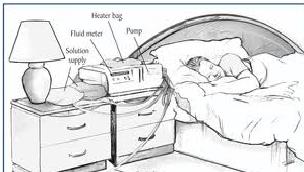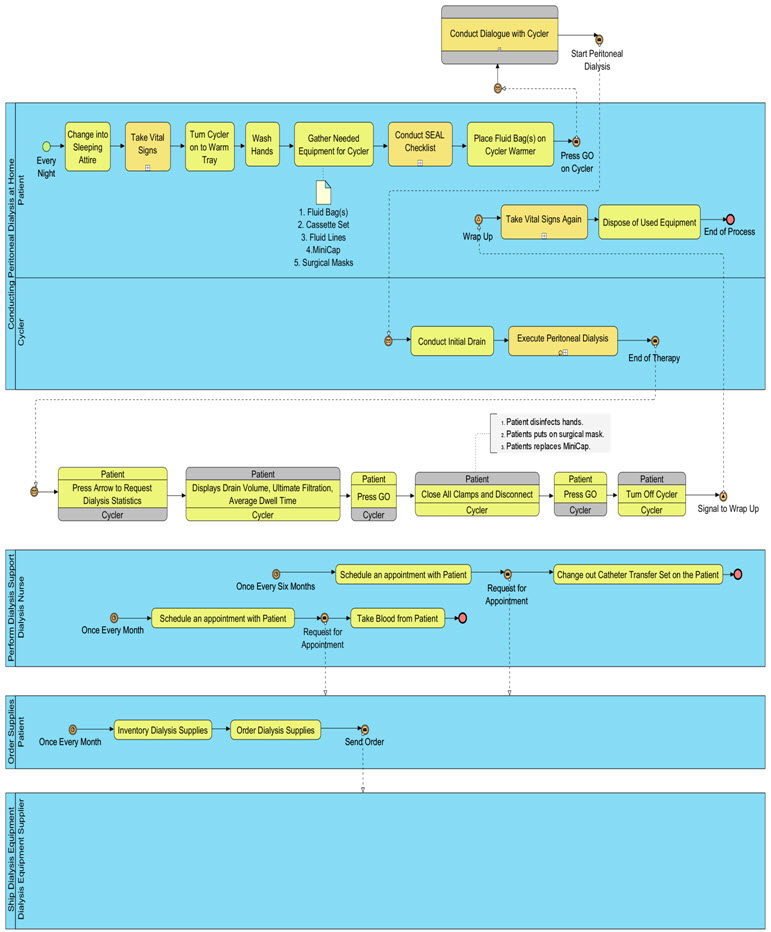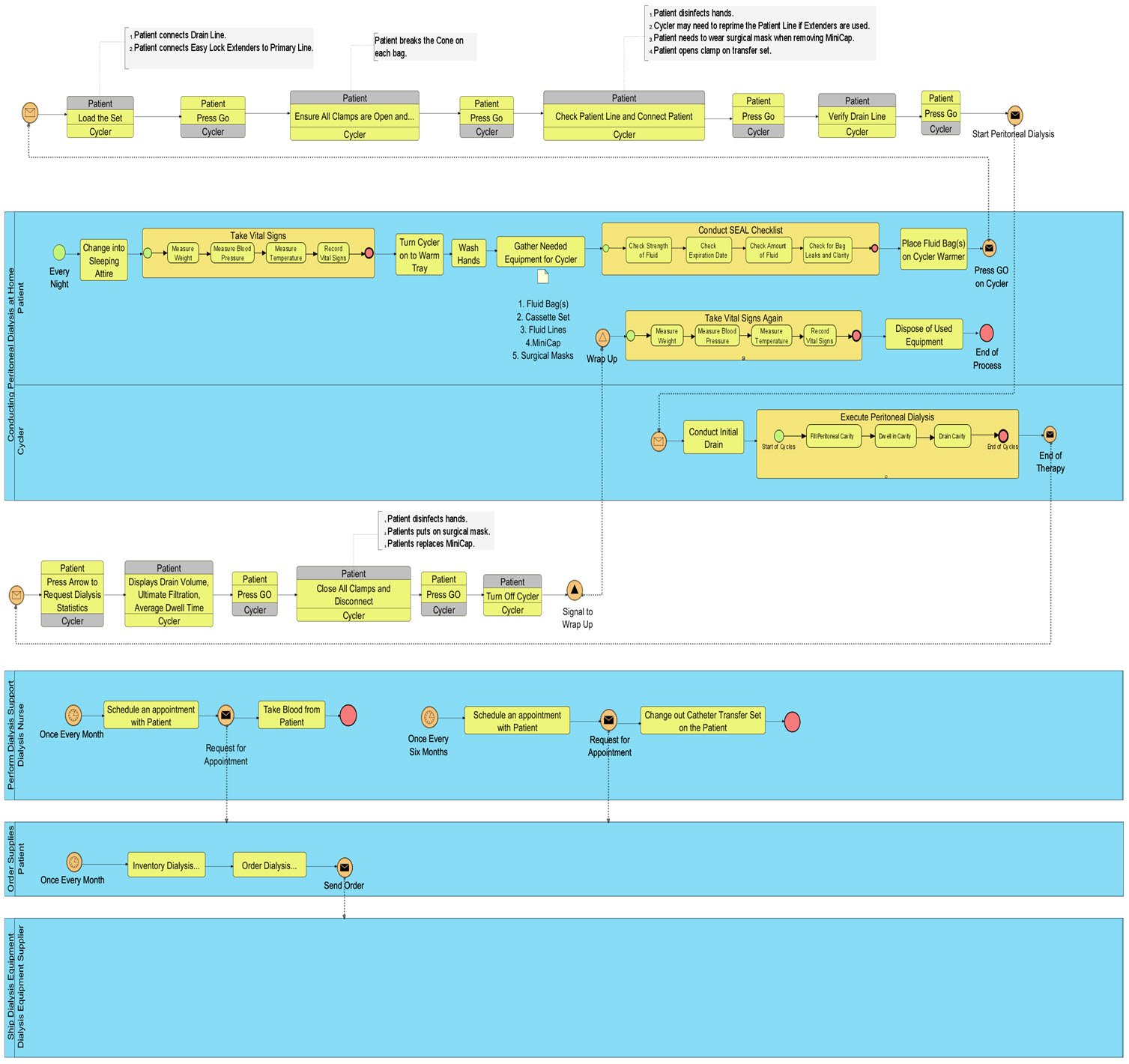The purpose of this article is to show an example of using Business Process Model and Notation (BPMN) to document the home medical process of peritoneal dialysis plus using 5S principles in the treatment workspace. Caveat: The information provided in this article is not intended to be a substitute for professional medical advice. A licensed healthcare professional should be consulted for diagnosis and treatment of any and all medical conditions.
Recently, my wife was diagnosed with poor performing kidneys and was introduced to peritoneal dialysis as opposed to hemodialysis. In being trained in this home procedure, I noted there were good text instructions, but no graphic model of the process. To ensure my understanding of the process, I developed the following graphic model using BPMN orchestration, collaboration, and choreography. In the summary of the article, I also make some comments on using the 5S principles in the treatment workspace.
 An alternate to hemodialysis, peritoneal dialysis (PD) is a treatment for kidney disease that uses the patient's stomach peritoneum. Fluid is introduced through an abdominal catheter and flushed out every night while the patient sleeps. This is called automatic peritoneal dialysis (APD) and utilizes a machine called a Cycler. There is another PD process that involves regular exchanges throughout the day; this is called continuous peritoneal dialysis (CPD). For the purpose of this article, we will focus on (APD).
An alternate to hemodialysis, peritoneal dialysis (PD) is a treatment for kidney disease that uses the patient's stomach peritoneum. Fluid is introduced through an abdominal catheter and flushed out every night while the patient sleeps. This is called automatic peritoneal dialysis (APD) and utilizes a machine called a Cycler. There is another PD process that involves regular exchanges throughout the day; this is called continuous peritoneal dialysis (CPD). For the purpose of this article, we will focus on (APD).
BPMN Model
The model involves the following actors in three pools with swim lanes:
• Patient
• Cycler - machine that cycles cleansing fluid
• Dialysis Nurse
• Dialysis Equipment Supplier
I chose to call the overall process, “Conducting Peritoneal Dialysis at Home.” I depict the process in one pool with two swim lanes in Figure 1. The actor Patient initiates the process via an orchestration (process within a pool). The process then turns into choreography (dialogue among actors) between the Patient and the actor, Cycler, the machine that cycles the cleansing fluid through the stomach’s peritoneum. After the choreography is complete, the Cycler completes the process as an orchestration and executes the cyclical dialysis.
Three other pools are involved in supporting the overall process: “Perform Dialysis Support,” “Order Supplies,” and “Ship Dialysis Equipment.” Each pool has single swim lanes: Dialysis Nurse, Patient, and Dialysis Equipment Supplier. The actor, Dialysis Nurse, sends messages to the Patient actor for blood test and catheter transfer set replacement appointments monthly and every six months, respectively. After the appointments are scheduled, the Dialysis Nurse actor executes the orchestration within its swim lane. There is also a “Ship Dialysis Equipment” pool containing the Dialysis Equipment Supplier actor which involves the same actor Patient pool sending messages for delivery requests for needed supplies on a monthly basis. These message exchanges between pools are called collaborations. Note that in the “Ship Dialysis Equipment” pool, the supplier process (orchestration) is unknown and therefore represented as a black box pool.

Figure 1.Summary View of Home Peritoneal Process
With that overview, let’s look at the details of the “Conducting Peritoneal Dialysis at Home” process. Since APD is done while the Patient sleeps, the first task is to “Change into Sleeping Attire.” The next task, “Take Vital Signs”, is a summary task; using summary tasks keeps the overall model at a high-level and easier to understand. I show the sub tasks in Figure 2 where the Patient takes measurements for weight, blood pressure, and temperature.

Figure 2. Sub Tasks for Take Vital Signs
Once those sub tasks are complete, the Patient then performs the task “Turn on the Cycler to Warm Tray.” The warming tray is on top of the Cycler and eventually warms the bag of cleansing fluid. While the tray is warming, the Patient performs the task “Wash Hands” to ensure a clean (not sterile) environment. The Patient then performs the task “Gather the Needed Equipment.” I show the equipment list as a data object and associated it with the task. It consists of the following:
1. Cleansing Fluid Bag(s)
2. A Cassette Set (include lines for Bag(s), Primary Patient Fluid Feed, and Fluid Drainage)
3. Fluid Lines (includes Easy Lock Extenders for Patient mobility)
4. MiniCap (used when resealing catheter transfer set on Patient)
5. Surgical Mask (used when attaching/disconnecting Primary Patient Fluid Feed)
With the equipment available, the Patient then performs the summary task “Conduct SEAL Checklist.” I show the sub tasks for this summary in Figure 3. These sub tasks involve the Patient checking the strength, expiration date, amount, and any leakage of the fluid bag(s). Assuming the checklist is complete, the Patient performs “Place the Fluid Bag(s) on the Cycler Warming Tray.” The Patient then completes the orchestration by performing the final two tasks, “Connect Drain Line” and “Connect Easy Lock Extenders to Primary Line.”

Figure 3. Sub Tasks for Conduct SEAL Checklist
At this point, the Patient is now ready to start the choreography by sending a request to the Cycler (press GO on the machine). I represent the choreography by a summary task, “Conduct Dialogue with Cycler.” I show the actual dialogue between the Patient and the Cycler in Figure 4. The dialogue starts with the Patient pressing GO a second time. The Cycler then responds and requests the Patient to load the cassette set; note additional Patient tasks in the annotation*. Upon loading the set, the Patient presses GO in response. The Cycler then asks the Patient to ensure that all the clamps of the lines are open and to connect the Bag(s); note an additional Patient task in the annotation*. Completing these tasks, the Patient once more responds GO. The Cycler then asks the Patient to check the primary line and to connect the Patient catheter to the fluid line; note additional Patient tasks in the annotation*. Once complete, the Patient responds GO. Finally, the Cycler asks the Patient to verify the drain line. Given the verification, the Patient responds with a final GO.
*For completeness, I used annotations to include tasks outside the choreography, but necessary to the process.

Figure 4. Patient/Cycler Choreography
With the choreography complete, the final GO causes a message to the Cycler to start an orchestration in the Cycler swim lane. The Cycler performs the task “Conduct Initial Drain.” When the initial drain completes, the Cycler then performs the summary and iterative task “Execute Peritoneal Dialysis.” I show the sub tasks for this summary in Figure 5. It consists of several iterations of three sequential sub tasks: “Fill Peritoneal Cavity”, “Dwell in Cavity”, and “Drain Cavity.” When the iterations are complete, the therapy ends.

Figure 5. Sub Tasks for Execute Peritoneal Dialysis
When the therapy is over, the Patient is ready to start a second choreography with the Cycler; see Figure 1. The Patient requests therapy statistics by pressing the down arrow on the Cycler. After the Cycler provides the statistics, the Patient presses GO and the Cycler requests the Patient to close all clamps. When the clamps are closed, the Patient presses GO. In response, the Cycler tells the Patient to disconnect. The Patient dons the surgical mask, disconnects from the patient line and places a new MiniCap on the end of the transfer set. The Patient then presses GO on the Cycler which responses by requesting the Patient to turn it off. Upon turning off the machine, the Patient wraps up the process by performing the “Take Vital Signs Again” summary task; see Figure 2 for sub tasks. Finally, the Patient finishes with the task “Dispose of Used Equipment” which includes the used cassette and lines.

Figure 6. Home Peritoneal Process with Sub Processes
(click image for detailed view)
Summary and a Word about 5S
The purpose of this article was to give a BPMN model example of the home dialysis process called Peritoneal. Figure 6 is the expanded version of Figure 1 with sub processes shown. The model consists of multiple pools with swim lanes exhibiting orchestrations, collaborations, and choreographies. Annotations are provided on choreography background tasks for completeness. Note that for simplicity, this example omits some set-up tasks such as tidal and last fill options plus exceptions that can occur during the process like line blockages and bypasses. I recommend in developing models to focus on a high-level and positive path first to ensure the process is correct. Once that is accomplished, incorporate the exceptions.
Writing this article was therapeutic for me in supporting our life style change. Developing and validating the BPMN model gave me further recognition how business analysis techniques can assist us in our own personal lives. It gave us insight and confidence on understanding and executing the peritoneal dialysis home process. We hung an enlarged version of figure 6 in the bedroom and follow the model each night to ensure correct protocols and avoid infections such as peritonitis.
In addition, we follow the “5S” principles developed by Hiroyuki Hirano for manufacturing workplaces in support of Lean process improvement. In this context, the workplace is our treatment workspace for managing equipment and supplies.
-
Sort – we removed unnecessary items from the dialysis workspace
-
Set in order – we arranged equipment and supplies so that they are easily accessed and clearly labeled (a place for everything and everything in its place)
-
Systematic cleaning – we keep the area clean (but, not sterile); vital to prevent infection
-
Standardize – we have established a procedure for conducting the dialysis (protocol) by using the BPMN model
-
Sustain – we review our workspace on a periodic basis to ensure we follow the 5S principles and that we incorporate up-to-date equipment and supply information along with lessons learned in the BPMN model
Further Reading
 Author: Mr. Monteleone holds a B.S. in physics and an M.S. in computing science from Texas A&M University. He is certified as a Project Management Professional (PMP®) by the Project Management Institute (PMI®), a Certified Business Analysis Professional (CBAP®) by the International Institute of Business Analysis (IIBA®), a Certified ScrumMaster (CSM) and Certified Scrum Product Owner (CSPO) by the Scrum Alliance, and certified in BPMN by BPMessentials. He holds an Advanced Master’s Certificate in Project Management (GWCPM®) and a Business Analyst Certification (GWCBA®) from George Washington University School of Business. Mark is also a member of the Association for the Advancement of Cost Engineering (AACE) International and the International Association of Facilitators (IAF).
Author: Mr. Monteleone holds a B.S. in physics and an M.S. in computing science from Texas A&M University. He is certified as a Project Management Professional (PMP®) by the Project Management Institute (PMI®), a Certified Business Analysis Professional (CBAP®) by the International Institute of Business Analysis (IIBA®), a Certified ScrumMaster (CSM) and Certified Scrum Product Owner (CSPO) by the Scrum Alliance, and certified in BPMN by BPMessentials. He holds an Advanced Master’s Certificate in Project Management (GWCPM®) and a Business Analyst Certification (GWCBA®) from George Washington University School of Business. Mark is also a member of the Association for the Advancement of Cost Engineering (AACE) International and the International Association of Facilitators (IAF).
Mark is the President of Monteleone Consulting, LLC and author of the book, The 20 Minute Business Analyst: a collection of short articles, humorous stories, and quick reference cards for the busy analyst. He can be contacted via – www.baquickref.com.